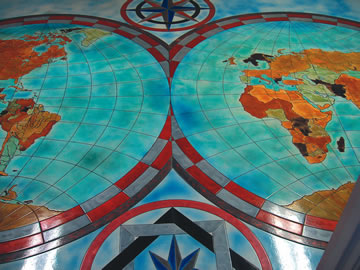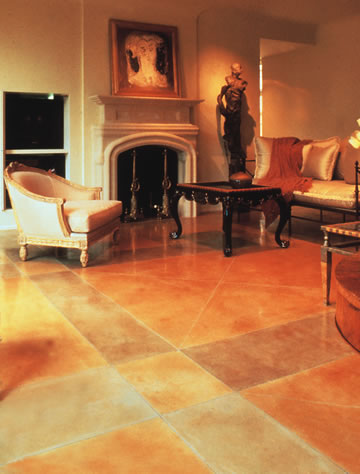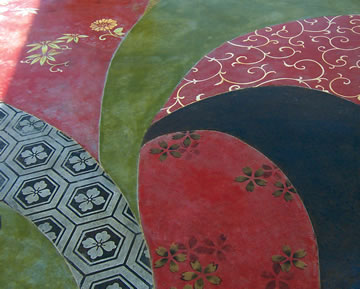Decorative Concrete
 Why decorative concrete?
Why decorative concrete?
There are a number of reasons to consider decorative concrete for your next project:
Cost — decorative concrete floors compare favorably with wood, ceramic, or quarry tile floors when amortized over the life of the floor. When elaborate designs and complex patterns are incorporated, concrete can save money when compared to marble or slate.
Craftsmanship — decorative concrete installed by a quality concrete craftsman offers an unlimited color palette. Every application is unique and can be customized to meet the desires of a homeowner.
Durability — when properly installed, concrete is one of the most durable materials on earth. Properly maintained, decorative concrete will last for many decades.
Health — decorative concrete is a great alternative to carpeting for people suffering from respiratory ailments and allergies.
Optimal Radiant Heating — whether in a slab-on-ground or cement-based topping, decorative concrete is ideal for use with radiant floor heating due to its excellent thermal mass properties.
How does decorative concrete get its color?
 There are a variety of ways to achieve the distinctive colors found in decorative concrete. With integral coloring, the products are introduced at the ready-mix concrete plant, and come in dry, liquid, or granular form. Coloring mixed throughout the concrete allows for full-depth color. Using white cement in place of traditional gray portland cement can allow for additional color choices. Dry-shake color hardeners are applied topically to freshly placed concrete, coloring the top 3/16 inch of the surface. The advantages of the dry-shake method include improved finishability, an unlimited range of colors, and a hard, abrasion resistant surface. Reactive and passive stains enable the transformation of concrete into an enduring work of art. The mottled, variegated, and realistic look produced by staining existing concrete is often the most desirable feature of a decorative floor. When treated with a stain, no two floors are alike. Most stains can be applied to new or old, plain or colored concrete surfaces.
There are a variety of ways to achieve the distinctive colors found in decorative concrete. With integral coloring, the products are introduced at the ready-mix concrete plant, and come in dry, liquid, or granular form. Coloring mixed throughout the concrete allows for full-depth color. Using white cement in place of traditional gray portland cement can allow for additional color choices. Dry-shake color hardeners are applied topically to freshly placed concrete, coloring the top 3/16 inch of the surface. The advantages of the dry-shake method include improved finishability, an unlimited range of colors, and a hard, abrasion resistant surface. Reactive and passive stains enable the transformation of concrete into an enduring work of art. The mottled, variegated, and realistic look produced by staining existing concrete is often the most desirable feature of a decorative floor. When treated with a stain, no two floors are alike. Most stains can be applied to new or old, plain or colored concrete surfaces.
What are my options?
There are a variety of techniques available to achieve the desired look:
Concrete Countertops — these can be cast-in-place at the customer’s residence or pre-fabricated off site and delivered for installation and finishing. The ability to integrate sloped drain boards, brass rails, and removable cutting boards and/or incorporate items such as crushed glass or seashells into the design add to their appeal.
Polished Concrete — grinding in successive passes with diamond tools over the concrete surface creates a high-luster finish similar to marble. This is one of the fastest growing processes in decorative concrete because of its distinctive look and reduced maintenance costs.
Skim Coats and Micro Toppings — a thinly applied material placed atop existing concrete can be layered in multiple lifts to create dimensional effects. Finishes can be broomed, troweled, or textured. These cement-based toppings provide great durability with a distinctive look.
Stamped and Textured Concrete — using this method, semi-hardened fresh concrete is stamped with special tools that make plain concrete mimic materials such as slate, stone, or brick. With advancements in stamping tools and coloring methods, it’s almost impossible to distinguish between natural materials and decorative concrete.
Stamped Overlay — a decorative poured-in-place topping made from colored or uncolored cementitious high performance material is placed on top of existing concrete, then textured and stamped. Many of the same techniques used with traditional stamped concrete can be used when stamping an overlay.
Stenciled Concrete and Overlays — through the use of paper stencils, this is a method of creating a particular pattern on existing or freshly placed concrete, replicating brick, cobblestone, and other shapes.
 What should I look for to be sure I'm getting a quality installation?
What should I look for to be sure I'm getting a quality installation?
Decorative flooring is a big investment, so the quality of the materials you are specifying and the reputation of the contractor are important considerations. According to the Tile Roofing Institute, there are several points to remember when choosing an installation contractor:
Referrals — Always obtain referrals from builders and homeowners who have used concrete tile contractors. Meet with them to get an appreciation for their commitment to quality and value in your job.
Look for a professional — Do they have a reputation for honesty and quality? Do they complete their jobs on time and within budget? Do they understand and abide by manufacturer specifications for installation?
Do your homework — Evaluate potential contractors’ insurance policies and record their professional license number so that you can ask your state’s Department of Professional Regulation and Licensing about its validity. Keep a healthy skepticism about performance claims and check with the Better Business Bureau to see if there are any claims against a contractor.
Sign the contract — Do not allow your contractor to begin work until you have both signed a contract specifying the terms of the work, the start and end date, lien releases, warranties, responsibility for permits, the total installed cost and a payment schedule. Make sure they agree to keep the job site neat, clean and safe throughout the installation process.
What's the bottom line?
Make sure to select an installer familiar with the manufacturer’s recommendations for quality and don’t hesitate to ask for references. A reputable contractor should be glad to provide a list of successful projects. You may also consider constructing samples or mockups before moving forward with your project. Make sure the finished product is designed appropriately for your climate and capable of withstanding natural forces that may affect its service life. It’s also important to protect your investment when using decorative concrete, so speak with your contractor about proper maintenance procedures.